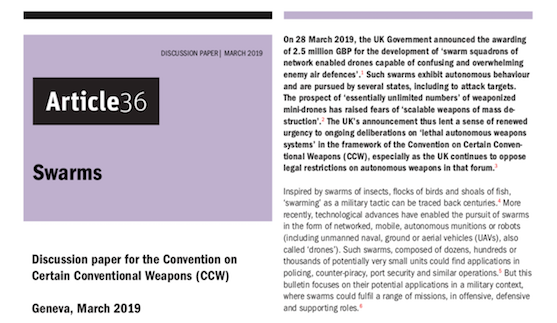
17.06.19
Swarms: networked, mobile, and autonomous
By Richard Moyes
Autonomous weapons Drones in the use of force Science, technology and weaponisation
Article 36’s recent bulletin on swarms, the latest in our Science, Technology and Weaponization series, summarises the reported military advances in swarming technologies as well as recent policy commentary on the topic and areas of concern.
Inspired by swarms of insects, flocks of birds and shoals of fish, ‘swarming’ as a military tactic can be traced back centuries. More recently, technological advances have enabled the pursuit of swarms in the form of networked, mobile, autonomous munitions or robots – including unmanned naval, ground or aerial vehicles (UAVs), more commonly known as ‘drones’. In a military context, swarms could potentially fulfil a range of missions, in offensive, defensive and supporting roles.
Unsurprising, then, that several states are pursuing swarm technology. In March this year the UK government announced multi-million funding for the development of ‘swarm squadrons’, while the US, China, European Union and several European nations, as well as a handful of other states, have all reportedly invested in the technology.
But the prospect of ‘essentially unlimited numbers’ of weaponized mini-drones has raised fears of ‘scalable weapons of mass destruction’ whilst also lending a sense of renewed urgency to ongoing deliberations on ‘lethal autonomous weapons systems’ in the framework of the Convention on Certain Conventional Weapons (CCW). Our bulletin flags these areas of concern and significant potential risks, particularly from the perspective of international and human security and disarmament.
Download this discussion paper
Discussion Paper
March 2019
